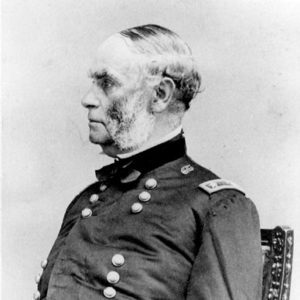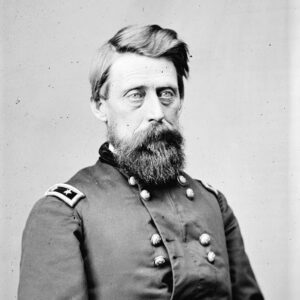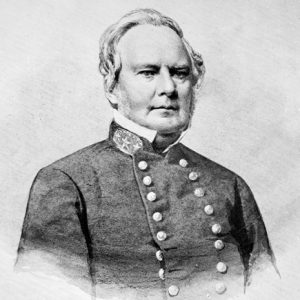calsfoundation@cals.org
Action at Pott's Hill
aka: Skirmish at Big Sugar Creek
| Location: | Benton County |
| Campaign: | Pea Ridge |
| Date: | February 16, 1862 |
| Principal Commanders: | Major General Samuel R. Curtis (US); Major General Sterling Price (CS) |
| Forces Engaged: | First Missouri Cavalry (US); First Missouri Cavalry (CS) |
| Estimated Casualties: | 1 killed, 5 wounded (US); 16 killed, unknown wounded (CS) |
| Result: | Union victory |
The Action at Pott’s Hill, also known as the Skirmish at Big Sugar Creek, on February 16, 1862, was the first engagement between Union and Confederate armies in Arkansas during the Civil War. The action was a precursor to the Battle of Pea Ridge on March 7–8, 1862.
As Brigadier General Samuel Curtis’s Union Army of the Southwest marched south toward Arkansas in February, pursuing Major General Sterling Price’s Confederate Army of the West, the Union front met the Confederate rear guard just across the Arkansas border, north of Pea Ridge (Benton County). Curtis, who had sent his men on a forced march south in search of the fleeing Confederates, was determined to engage Price’s army as soon as possible. Price’s ragtag Confederate army was a constant nuisance for Union trans-Mississippi operations, and Major General Henry Halleck ordered Curtis to rid southern Missouri and northern Arkansas of the problem. The two armies clashed first at Pott’s Hill and, less than a month later, at Pea Ridge. While pushing Price south, a portion of Curtis’s front guard made contact with Confederates just south of the Missouri border at Pott’s Hill.
By February 16, when contact was made, both sides were exhausted as the Army of the Southwest’s advance force, the First Missouri Union Cavalry, pushed through dense undergrowth along Telegraph Road into Arkansas. One Rebel soldier remembered that the Federals “had followed us so steadily and closely, that we had no time to rest, eat or sleep upon the route.” Trudging through what was known as Cross Timber Hollow, Colonel Calvin A. Ellis and his First Missouri Cavalry (Union) happened upon Henry Little’s First Missouri Cavalry (Confederate) and a detachment of Captain Churchill Clark’s Missouri Battery. Ellis immediately requested reinforcements as the Confederates fled south. Upon reaching Ellis’s detachment, Jefferson C. Davis, commander of the Third Division of the Army of the Southwest, ordered Ellis to overtake the Rebel forces before they were able to dig in. Soon after receiving the order, the First Missouri Cavalry (Union) barreled through the difficult terrain after the fleeing Rebels. Upon emerging from the worst of Cross Timber Hollow, in the Big Sugar Creek valley, the Federal cavalry gained sight of the Rebel First Missouri Cavalry. The Union Missourians did not slow as they ran into the Confederate rear guard, and “heavy fire with double-barreled shotguns was poured into them at a range of fifty yards.” The Union and Confederate First Missouri cavalries thereafter fought a fierce galloping battle along narrow Telegraph Road. The two-gun detachment from Clark’s Missouri Battery was soon enveloped in the ensuing scrap, pitting un-mounted and poorly armed Confederate artillerymen against the Federal cavalry. Although able to fire some rounds into the Union forces, Clark’s artillery was overwhelmed. Lieutenant Colonel Clark Wright, fighting alongside Ellis’s charging Union cavalry, reported that, after a “well contested” fight, he “routed the enemy, driving him beyond the brush into the open ground.” The overzealous Federal cavalry overran the Confederate lines and had to turn around to redirect its attack.
Upon hearing what was happening to his rearguard, Little promptly ordered a swift countermarch against the advancing Union cavalry. His Confederates, worn out from hard marching, were unable to aide effectively the struggling First Missouri Rebel Cavalry and the detached artillery battery. Little, therefore, ordered all Rebel forces engaged to fall back to Big Sugar Creek and await further reinforcement.
Thus ended the brief but vicious scrap between the Union and Confederate First Missouri cavalries north of Pea Ridge. Upon seeing the Confederate withdrawal, Federal forces fell back across the Missouri line, setting up camp a mile from Arkansas. The heaviest fighting lasted approximately twenty minutes. The Action at Pott’s Hill, as it later became known, resulted in minimal casualties for each side. Federal forces reported one killed and five wounded; Confederate forces had sixteen killed and an unknown number wounded. Three weeks later, each side met again a few miles south of Pott’s Hill at the Battle of Pea Ridge.
Today, the Action at Pott’s Hill is marked by a small explanatory sign erected by the Pea Ridge Memorial Association in 1962 as part of the centennial observance.
For additional information:
Anderson, Ephraim M. Memoirs: Historical and Personal; Including the Campaigns of the First Missouri Confederate Brigade. St. Louis: Morningside House, Inc., 1988.
Christ, Mark, ed. Rugged and Sublime: The Civil War in Arkansas. Fayetteville: University of Arkansas Press, 1994.
Shea, William L., and Earl J. Hess. Pea Ridge: Civil War Campaign in the West. Chapel Hill: University of North Carolina Press, 1992.
Matthew M. Stith
University of Arkansas, Fayetteville
 Samuel Curtis
Samuel Curtis  Jefferson C. Davis
Jefferson C. Davis  Sterling Price
Sterling Price 




The marker sign commemorating the Pott’s Hill Skirmish is located approximately a quarter to a half mile north of where the actual skirmish took place. From the Missouri border, head south to the first junction (small bridge); this is the location of Pott’s Hill.
I also know where the Union army camped just across the Missouri border just after the skirmish (incidentally, it was more than a mile as stated in the article-it was more like two to three miles). [Editor’s note: The discrepancy could be explained by modern highway miles versus a straight course plotted by a military officer at the time.]